AFKOM OES – the road to industry 4.0
The proprietary AFKOM OES (operation execution system) system is a modular system designed to support the implementation of operational tasks in the company, such as production, maintenance, quality management or inventory management. It combines the features of such systems as MES (manufacturing execution System), WMS (warehouse management system), FMC (Flow Material Control), SCM (supply chain management system) or CMMS (computerized maintenance management system).
The AFKOM OES system, unlike the ERP system, does not focus on settling what is happening in the plant, but on optimizing the processes that occur in it. According to the latest trends in accordance with the idea of industry 4.0 undertaking should:
- have its own digital model,which through the IT system will integrate with machines in production
- the machine should be equipped with a communication interface, through which they will be able to submit information about their condition and carried out tasks
- the machine should have the possibility to react on the fly to changing environmental conditions.
The AFKOM OES system as an Industry 4.0 system enables two-way data exchange between the system and machines and the creation of models of production processes along with integration with other processes. It has no limitations when it comes to the amount of collected parameters relating to the production process. The real-time product history created by the system may include:
- bit signals confirming e.g. the fact of closing the product housing, putting on the washer, spring, tightening the rivet, etc.,
- discrete parameters such as force, torque, path, number of revolutions, etc.,
- information about the components used, their packaging, suppliers
- information on the packaging of the finished product and its recipients
- information on movements and storage locations of packaging of components and products
- confirmation of performed operations with information about the machine, operator and production order
This ensures that communication with machines is bi-directional, the machine will receive up to date data from the system, that allow you to specify how the product is to be produced, how many pieces have to be produced, what components are used in the construction of, or product that is to be currently subjected to has correctly made all technological operations. Integration with machines can be so large that you may not be able to run the machine without approval from the system. At the same time, in the other direction, you can keep track of the degree of execution of production orders, the speed of flow of components in warehouses within the areas of the plant integrated with the system. This allows you to get a detailed dynamic picture of the plant at any time of its operation.
The system gives the opportunity to create multi-level models of production processes,in which certain stages are performed in the processes of pre-assembly or pre-preparation of components.
The flexible way of configuring the production process makes it possible to define universal machines that will be used optimally in different production processes depending on the current orders of customers.
The system is able to integrate all the production lines and machines within a single server. This gives you the opportunity to central planning and monitoring on a regular basis the implementation of the plan for the whole plant.
System AFKOM OES allows you to manage inventory as well as the flow of materials. With the proper configuration, it is possible to supervise:
- demand for components,
- packaging of products for transport packaging,
- transport of packaging with the product to the warehouse,
- segregation and placement of packaging in the warehouse
- time of the seasoning of the product
The system allows the transportation management manual (forklift with an operator) and automatic (automatic fork-lift trucks, railway wagons or transporter system and wind).
System AFKOM OES is optimized to process large amounts of data. At the same time it is a scalable, whose performance and functionality can be adjusted to the size of the plant.
The system has a modern scalable web interface of the "hamburger" type, which can be run both on a computer and on a smartphone or tablet. It allows quick system updates, available immediately to all users, as well as adjusting the system to the user's preferences.
Extensive user permissions allow you to create groups of users and define access to individual system windows for them. The login process allows you to integrate with your domain or social media. Currently, there is a Polish and English version, but it is possible to add other language versions.
Development of the AFKOM OES system
| 2013 | first implementation of the system in Poland |
| 2014 | adding the functionality of managing the flow of materials between warehouses using autonomous transport trolleys with automatic placement of transport units in the warehouse |
| 2015 | further implementations in Poland |
| 2016 | adding the functionality of controlling an autonomous pallet binder in the finished products warehouse with two-sided integration with the ERP system |
| 2017 | the system has been expanded in accordance with the EPCIS/GS1 standard |
| 2018 | implementation of the system in Germany and India,adding the option of statistical control of the production process |
| 2019 | The system has gained a new graphical template and has been tested on Oracle's Autonomous Cloud Database,which uses machine learning to eliminate the human work associated with database tuning, security, backups, updates, and other routine management tasks traditionally performed by database administrators. The system was the first Polish MES system to receive the "Powered by Oracle Cloud" certificate |
| 2020 | Adding the ability to work with IoT devices and expanding functions for Logistics |
Processes supported by AFKOM OES
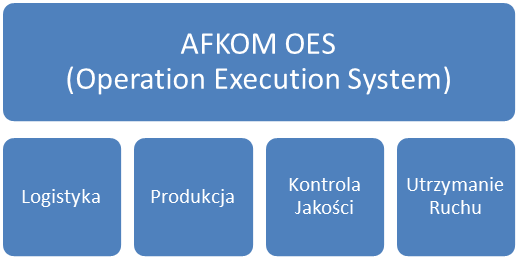
Sample system windows
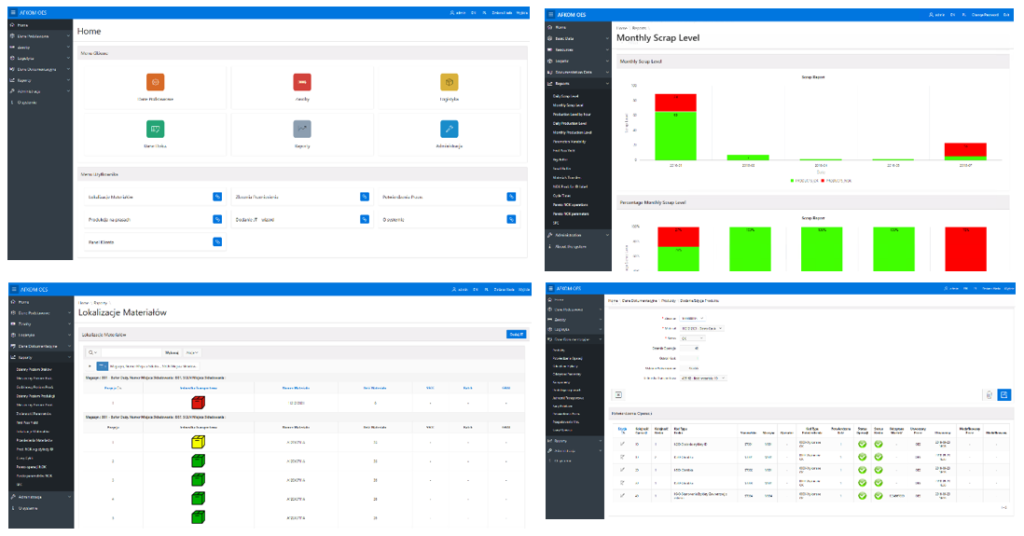
Examples of implementations of the AFKOM OES system
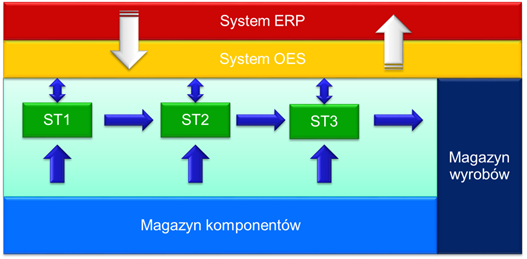
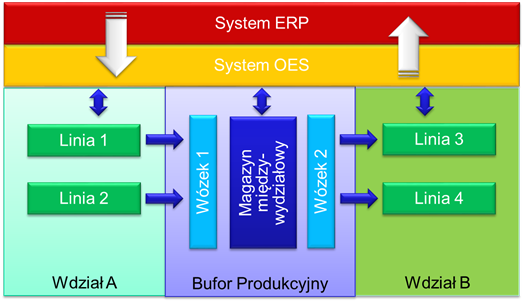
Areas of application of the AFKOM OES system
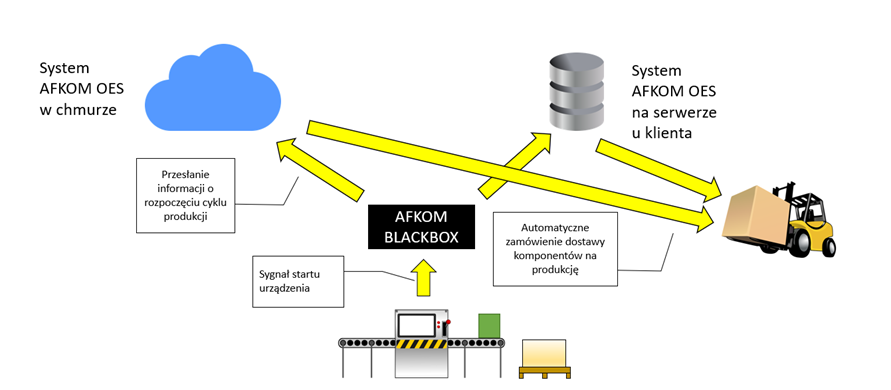
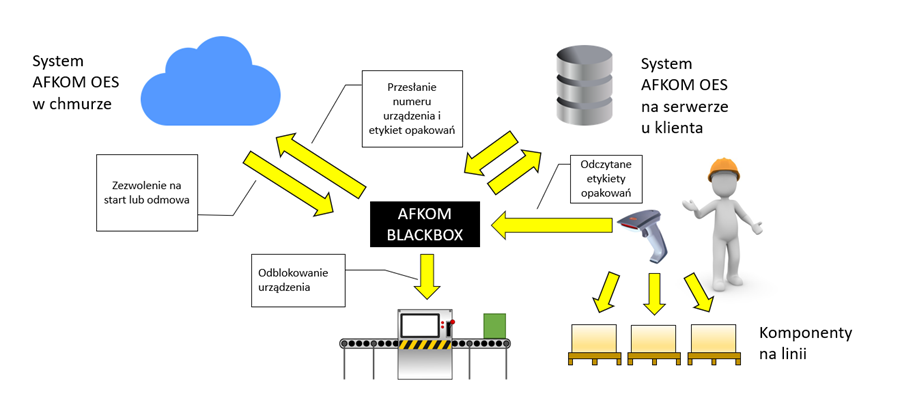
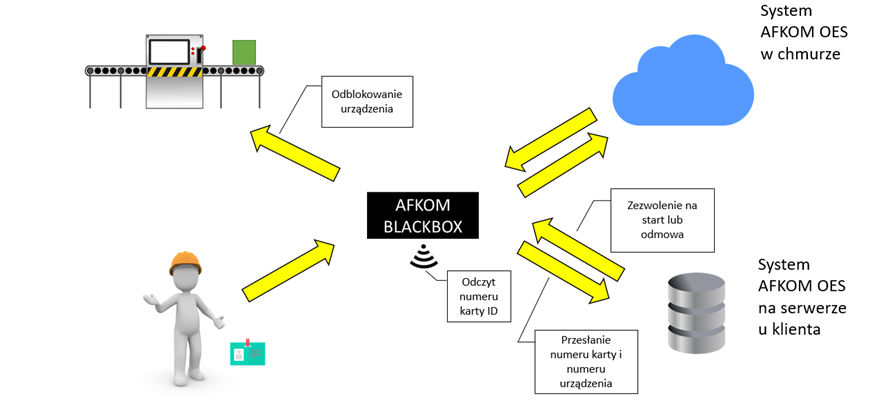
Benefits of implementing AFKOM OES
- quick integration of production processes
- increased productivity
- improving the organization of work
- optimal use of company resources
- increased efficiency with the same resources
- reduction of downtime
- extending the working time of machines through their regular maintenance
- detection of machines whose maintenance is unprofitable due to operating costs
- the ability to register changeover times and optimize the operation of the line in this respect
- the ability to detect the causes of uneven performance of production lines
- reduction of stocks of components, products and spare parts for machines
- reduction of bottlenecks in processes
- improving the quality of products and services
- fewer deficiencies
- fewer complaints and better handling,
- possibility of blocking the use of defective components for the production of products
- the ability to block the shipment of defective products
- the ability to verify that the recipient does not have defective products
- the ability to supervise whether quality control of products has been carried out and the ability to control the type of control
- the ability to detect theft of products in the plant or in transport
- the ability to track production on an ongoing basis – execution of orders, tracking product flow, tracking the supply of components and transport containers in production.
- reducing the number of paper documents on the lines
Our experience shows that the implementation of this system allows an increase in efficiency of up to 30%.